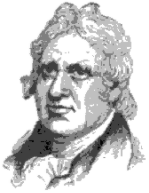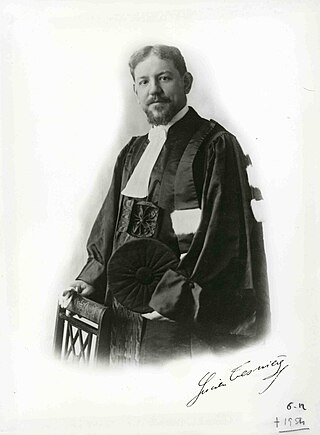Related Research Articles
In linguistics, the grammar of a natural language is its set of structural rules on speakers' or writers' usage and creation of clauses, phrases, and words. The term can also refer to the study of such rules, a subject that includes phonology, morphology, and syntax, together with phonetics, semantics, and pragmatics. There are, broadly speaking, two different ways to study grammar: traditional grammar and theoretical grammar.
Old English, or Anglo-Saxon, is the earliest recorded form of the English language, spoken in England and southern and eastern Scotland in the early Middle Ages. It developed from the languages brought to Great Britain by Anglo-Saxon settlers in the mid-5th century, and the first Old English literary works date from the mid-7th century. After the Norman Conquest of 1066, English was replaced for several centuries by Anglo-Norman as the language of the upper classes. This is regarded as marking the end of the Old English era, since during the subsequent period the English language was heavily influenced by Anglo-Norman, developing into what is now known as Middle English in England and Early Scots in Scotland.

Jens Otto Harry Jespersen was a Danish linguist who specialized in the grammar of the English language. Steven Mithen described him as "one of the greatest language scholars of the nineteenth and twentieth centuries."

Robert Lowth was a Bishop of the Church of England, Oxford Professor of Poetry and the author of one of the most influential textbooks of English grammar.
In linguistics, syntax is the study of how words and morphemes combine to form larger units such as phrases and sentences. Central concerns of syntax include word order, grammatical relations, hierarchical sentence structure (constituency), agreement, the nature of crosslinguistic variation, and the relationship between form and meaning (semantics). There are numerous approaches to syntax that differ in their central assumptions and goals.

Priscianus Caesariensis, commonly known as Priscian, was a Latin grammarian and the author of the Institutes of Grammar, which was the standard textbook for the study of Latin during the Middle Ages. It also provided the raw material for the field of speculative grammar.

A parse tree or parsing tree or derivation tree or concrete syntax tree is an ordered, rooted tree that represents the syntactic structure of a string according to some context-free grammar. The term parse tree itself is used primarily in computational linguistics; in theoretical syntax, the term syntax tree is more common.

Alexander Bain was a Scottish philosopher and educationalist in the British school of empiricism and a prominent and innovative figure in the fields of psychology, linguistics, logic, moral philosophy and education reform. He founded Mind, the first ever journal of psychology and analytical philosophy, and was the leading figure in establishing and applying the scientific method to psychology. Bain was the inaugural Regius Chair in Logic and Professor of Logic at the University of Aberdeen, where he also held Professorships in Moral Philosophy and English Literature and was twice elected Lord Rector of the University of Aberdeen.

Moses B. Stuart was an American biblical scholar.
The term phrase structure grammar was originally introduced by Noam Chomsky as the term for grammar studied previously by Emil Post and Axel Thue. Some authors, however, reserve the term for more restricted grammars in the Chomsky hierarchy: context-sensitive grammars or context-free grammars. In a broader sense, phrase structure grammars are also known as constituency grammars. The defining trait of phrase structure grammars is thus their adherence to the constituency relation, as opposed to the dependency relation of dependency grammars.
In linguistics, a grammatical agent is the thematic relation of the cause or initiator to an event. The agent is a semantic concept distinct from the subject of a sentence as well as from the topic. While the subject is determined syntactically, primarily through word order, the agent is determined through its relationship to the action expressed by the verb. For example, in the sentence "The little girl was bitten by the dog", girl is the subject, but dog is the agent.
The term predicate is used in two ways in linguistics and its subfields. The first defines a predicate as everything in a standard declarative sentence except the subject, and the other defines it as only the main content verb or associated predicative expression of a clause. Thus, by the first definition, the predicate of the sentence Frank likes cake is likes cake, while by the second definition, it is only the content verb likes, and Frank and cake are the arguments of this predicate. The conflict between these two definitions can lead to confusion.
Charles Edwin Bennett was an American classical scholar and the Goldwin Smith Professor of Latin at Cornell University. He is best remembered for his book New Latin Grammar, first published in 1895 and still in print today.

Lucien Tesnière was a prominent and influential French linguist. He was born in Mont-Saint-Aignan on May 13, 1893. As a senior lecturer at the University of Strasbourg (1924) and later professor at the University of Montpellier (1937), he published many papers and books on Slavic languages. However, his importance in the history of linguistics is based mainly on his development of an approach to the syntax of natural languages that would become known as dependency grammar. He presented his theory in his book Éléments de syntaxe structurale, published posthumously in 1959. In the book he proposes a sophisticated formalization of syntactic structures, supported by many examples from a diversity of languages. Tesnière died in Montpellier on December 6, 1954.
In certain theories of linguistics, thematic relations, also known as semantic roles, are the various roles that a noun phrase may play with respect to the action or state described by a governing verb, commonly the sentence's main verb. For example, in the sentence "Susan ate an apple", Susan is the doer of the eating, so she is an agent; an apple is the item that is eaten, so it is a patient.
A Latin mnemonic verse or mnemonic rhyme is a mnemonic device for teaching and remembering Latin grammar. Such mnemonics have been considered by teachers to be an effective technique for schoolchildren to learn the complex rules of Latin accidence and syntax. One of their earliest uses was in the Doctrinale by Alexander of Villedieu written in 1199 as an entire grammar of the language comprising 2,000 lines of doggerel verse. Various Latin mnemonic verses continued to be used in English schools until the 1950s and 1960s.

Alexander Crombie FRS (1760–1840) was a Scottish Presbyterian minister, schoolmaster and philosopher.
The history of English grammars begins late in the sixteenth century with the Pamphlet for Grammar by William Bullokar. In the early works, the structure and rules of English grammar were based on those of Latin. A more modern approach, incorporating phonology, was introduced in the nineteenth century.

The introduction and early development of printing in South India is attributed to missionary propaganda and the endeavours of the British East India Company. Among the pioneers in this arena, maximum attention is claimed by the Jesuit missionaries, followed by the Protestant Fathers and Hindu Pandits. Once the immigrants realized the importance of the local language, they began to disseminate their religious teachings through that medium, in effect ushering in the vernacular print culture in India. The first Tamil booklet was printed in 1554 in Lisbon - Cartilha em lingoa Tamul e Portugues in Romanized Tamil script by Vincente de Nazareth, Jorge Carvalho and Thoma da Cruz, all from the Paravar community of Tuticorin.
In linguistics, the autonomy of syntax is the assumption that syntax is arbitrary and self-contained with respect to meaning, semantics, pragmatics, discourse function, and other factors external to language. The autonomy of syntax is advocated by linguistic formalists, and in particular by generative linguistics, whose approaches have hence been called autonomist linguistics.
References
- ↑ Liberty and Responsibility in John Stuart Mill Archived February 3, 2011, at the Wayback Machine